
[ Back to Historical Fiction ] -> [ Back to Hamilton and Peggy: A Revolutionary Friendship ]
Supporting Characters
Hamilton and Peggy: A Revolutionary Friendship
(Lafayette, Spy Moses Harris, Lisbon and Prince, Hamilton’s Fellow Aides-de-Camp, Benedict Arnold, the Oneida Sachem, Poet Ann Bleecker, and a host of generals)
Lafayette
The young French idealist, Marie-Joseph Paul Yves Roch Gilbert du Motier, Marquis de Lafayette, was one of our Revolution’s most important figures. Born into a noble family with strong ties to the French crown, the Marquis could trace his ancestry all the way back to the Crusades and to comrades of Joan of Arc. After his father was killed in the Seven Years War and his mother died, Lafayette was merely eleven years-old when he inherited one of the largest fortunes in France. Raised mainly by his grandmother in Paris, he married Adrienne de Noailles, a teenager from an even more prominent family, when he was sixteen. Hardly the set-up for a Revolutionary.
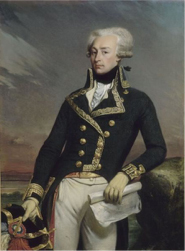
When he first arrived in Philadelphia, Congress refused to receive him—the legislature was tired of ambitious European officers arriving and announcing they were there to save the Americans. But when Congressman James Lovell of MA realized who Lafayette was, and how rich and connected to the French court he was, he appointed Lafayette a Major-General and sent him to George Washington’s headquarters on Brandywine Creek.
Although Washington really had no idea what to do with the young nobleman, he was quickly charmed by Lafayette’s modesty and optimism. During the Battle of Brandywine, Lafayette fought bravely under General Sullivan, even when he was shot through the calf. Dr. John Cochran, Peggy’s uncle, operated on the battlefield, told by Washington to care for the young Frenchman as if he were the general’s own son.
From then on, Washington and Lafayette enjoyed an almost father-son bond. Washington’s “trust in me is deeper than I dare say,” Lafayette wrote to his wife on January 6, 1778, from Valley Forge. “In the place he occupies, he is surrounded by flatterers and secret enemies. He finds in me a trustworthy friend in whom he can confide and who will always tell him the truth. Not a day goes by without his talking to me at length or writing long letters to me. And he is willing to consult me on most interesting points.”
Washington promoted Lafayette to command a division under Major General Nathanael Greene. Lafayette served the cause without pay—spending the equivalent of $200,000 of his own money for the salaries and uniforms for his staff, aides , and junior officers. He became such a valuable advisor and confidante to Washington, the British were determined to capture Lafayette as a demoralizing stroke of propaganda. The British Army deployed 7,000 Redcoats to entrap Lafayette and his 2,200 men at Barren Hill. The young Frenchman was saved by his best marksmen and 50 Oneida Indians he had recruited to the American cause. Screened by the Oneida and Patriot riflemen, Lafayette was able to rush his troops across the Schuylkill River with the soldiers holding hands so that the current wouldn’t drag them downstream or drown them.
After the Battle of Monmouth, Washington sent Lafayette back to France to plead help from the king. Emboldened by his time with American revolutionaries, Lafayette stood before the king (who had forbad his going to the Americas) dressed in his Continental Army uniform. Even so, Lafayette’s eloquence and diplomacy convinced Louis XVI to send Rochambeau’s Army to aide the Patriots. Lafayette returned to America with Rochambeau and was instrumental in the Continental Army’s fight in Virginia. He severely weakened British forces through guerrilla warfare operations before the Battle of Yorktown and then fought bravely during it. After the Revolution ended, Lafayette and Washington’s friendship did not diminish. Lafayette named his only son after the great General, and the two exchanged letters until Washington passed away in 1799.
At first, Lafayette proudly participated in the French Revolution, serving in the National Assembly that drafted France’s Declaration of the Rights of Man. He sent President Washington the key of the infamous Bastille in celebration of freedom and America’s example of democracy. But when the Revolution’s leaders turned on noblemen and executed hundreds, Lafayette had to flee to Austria, where he was imprisoned for five years as a dangerous radical. In 1824, Lafayette returned to his beloved America to visit, greeted as a hero. He is buried in Paris, near many of the French Revolution’s victims. Legend holds that he brought back a handful of dirt from Mount Vernon, which he wanted thrown onto his grave. An American flag has flown above his resting place since the end of WWI.
Sources:
http://www.mountvernon.org/digital-encyclopedia/article/marquis-de-lafayette/
http://www.history.org/almanack/people/bios/biolafayette.cfm
https://www.youtube.com/watch?v=N0N3BEWxQFo
Spy and Double-Agent Moses Harris
Moses Harris is one of those extraordinary “simple” citizen-soldiers whose stubborn, quick-witted courage was so integral to our winning the Revolutionary War.
In 1777, on his third re-enlistment, then Sergeant Harris was near New York’s Lake George on business for the 6th Dutchess County Regiment, probably as a courier. He accidentally came upon a party of exhausted Loyalists. Not dressed in any discernible uniform, Harris decided to play-act that he too was a Loyalist, in order to ascertain what these three men were up to. They confided in Harris they’d been sent to deliver official communiqués to a Loyalist agent in Albany, who was to get the letters to British commanders in Canada. The men had been evading Patriot patrols for hours and were resting (or hiding) in the high grass.
Recognizing the golden opportunity, and that the letters’ information had to be quite important to risk three men being hanged if caught, Harris announced he was heading to Albany himself. He would gladly deliver the packet for the gentlemen, saving them further trouble and danger. Harris must have been quite the clever and convincing chameleon, because the British couriers trustingly handed him the communiqués! Harris then headed for Albany as promised, but straight to Philip Schuyler’s mansion, not to the Loyalist agent. (See Chapter Three of the novel). Harris’ astute and brave cunning may have saved western New York from falling to British forces. Those letters detailed Burgoyne’s three-prong strategy and Barry St. Leger’s planned attack on Fort Stanwix, which controlled the Mohawk River flowing to Albany. Schuyler was able to open the letters without breaking the seal, read and record their contents, and then reseal and send them on to the Loyalist agent, without the British realizing the information had been compromised. Knowing what was coming, Schuyler was able to forewarn militia units near Fort Stanwix to be ready for a fight.
That, as the saying goes, was the beginning of a beautiful arrangement! Harris would continue to serve Schuyler as a double agent, pretending to be a Loyalist courier, but in reality intercepting all the British intelligence he could to take straight to Schuyler. He also delivered false letters Schuyler devised to hide what Washington was really planning.
Harris’ pension application after the war confirmed his service. An 1878 article detailed stories Harris had told his grandchildren, including a rather amazing scene of his being saved from death by giving the Masonic sign of distress while being hanged by Redcoats and Tories. It seems one of the British officers was a fellow Mason and cut him down! According to his gravestone in Queensbury, New York, Harris lived to be 89 years, 11 months, and 24 days old.
I have to say, the bodacious Moses Harris became one of my most favorite fact-based characters to write—ever!
Sources:
http://revwarapps.org/s17996.
https://www.findagrave.com/
Lisbon and Prince
I hate lumping these men into one entry, but so little is known of these two enslaved servants and the sources below are the same, so I put Lisbon and Prince together. Thanks to the Schuyler Mansion historical interpreters meticulously searching through family documents, we know that as many as 13 people were enslaved under Philip Schuyler at his Albany mansion and probably another 30 at his Saratoga country estate.
Lisbon is the brave soul who accompanies Peggy on her dangerous trek to Morristown in Chapter 9. This is one of those instances in which I had to make a character decision as to what was plausible given the bare-boned facts I did know. In this case, who from the household staff would accompany Peggy? Lisbon was the logical choice as Schuyler’s papers mention him driving carts, wagons, and sleds between Albany and Saratoga. Records show he was with the Schuylers for at least 25 years.
Prince was Schuyler’s personal attendant and the enslaved servant who largely ran the mansion, greeting guests and serving at formal dinners. When Schuyler needed to create a coded cipher for letters to John Jay, then serving as an ambassador overseas, he choose Prince’s name. Without specifically saying it, he wrote Jay that their code would be the reverse spelling of the name of the person who handed Mrs. Schuyler a toothpick after dinner.
It is a disturbing and horrible irony that many of our founding fathers bought, sold, and owned fellow human beings even while fighting to liberate themselves from what they called tyranny. Two of Schuyler’s enslaved servants are documented as having run away, desperate for freedom. Those I mention by name in the novel are factual. From documents, it’s clear that Schuyler trusted Prince and Lisbon to protect his family, home, and expensive property like horses and sleighs that were critically necessary to their survival during a war. Several enslaved men fought to protect the Schuylers during the Loyalist raid on the mansion and attempted kidnapping of Philip.
The Schuyler Mansion blog has several in-depth posts on the people enslaved by the Schuylers, Hamilton’s involvement and attitude about slavery, and the tragic practice of it within New York. It was not until 1827 that the state outlawed slavery entirely.
Sources:
https://schuylermansion.blogspot.com/2016/06/an-overview-of-slave-trade-in-new.html
https://schuylermansion.blogspot.com/2017/08/can-do-all-sorts-of-housework-labor-of.html
https://schuylermansion.blogspot.com/2017/03/searching-for-enslaved-women-of.html
https://schuylermansion.blogspot.com/2016/12/who-were-servants-lisbon-dick-and-bob.html
https://schuylermansion.blogspot.com/2017/02/who-were-servants-tom-and-lewis.html
https://schuylermansion.blogspot.com/2016/06/a-child-named-hanover.html
On Hamilton and Slavery (two parts):
https://schuylermansion.blogspot.com/2016/11/mansion-mythbusters-hamilton-and.html
https://schuylermansion.blogspot.com/2016/12/mansion-mythbusters-hamilton-and.html
Washington’s Aides-de-Camp appearing in the novel:
1. James McHenry was an Irish-born surgeon for the 5th Pennsylvania Regiment. In 1776, McHenry was captured by the British during the invasion of Fort Washington. While a prisoner-of-war, he served as doctor for his fellow captives. In 1778, he was released and immediately returned to fighting for the cause. Two months later, Washington appointed McHenry to be his assistant secretary.
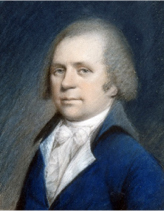
In 1780, McHenry moved to Lafayette’s staff as aide-de-camp, earning the rank of Major and fighting in the Battle of Yorktown. After the war, McHenry was a Maryland Senator until President Washington appointed him Secretary of War in 1796. McHenry’s legacy remains most prominently in the fort named for him, Baltimore’s Fort McHenry, where Francis Scott Key wrote “The Star-Spangled Banner” during The War of 1812.
Sources:
http://www.mountvernon.org/digital-encyclopedia/article/james-mchenry/
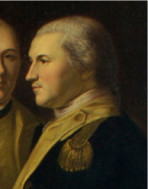
Tilghman had been one of the first to write about Eliza’s beauties: “I was prepossessed in favor of this young Lady the moment I saw her. A Brunette with the most good natured lively dark eyes that I ever saw which threw a beam of good temper and benevolence over her whole countenance. …I was not mistaken in my Conjecture for that she was the finest tempered Girl in the World.” He would nickname her “the little saint.”
Sources:
http://www.mountvernon.org/digital-encyclopedia/article/tench-tilghman/
https://allthingsliberty.com/2016/01/colonel-tench-tilghman-george-washington-eyes-ears/
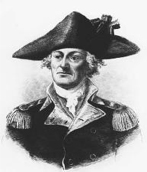
Source:
http://www.mountvernon.org/digital-encyclopedia/article/robert-hanson-harrison/
4. Before becoming a Washington aide-de-camp, Lieutenant Colonel Robert Kidder Meade served as Captain in the 2nd Virginia Regiment, fighting in the Battle of Great Bridge (featured in my other Revolutionary War novel about a young fifer, GIVE ME LIBERTY). As aide-de-camp, Meade did Washington’s "riding work” —(Hamilton, on the other hand, was renowned for performing writing/diplomatic duties)—so much so that Meade's black mare was well known by both the American and British armies. After the War, Meade retired to his Virginia farm.
Sources:
https://www.findagrave.com/memorial/11394351#
http://www.nps.gov/vafo/historyculture/richardkiddermeade.htm
5. George Augustine Washington. George Washington was a devoted uncle and during the war, his favorite nephew, the son of his younger brother Charles, was an ensign and member of the commander’s personal unit of guards. When Washington became president, George Augustine took care of Mount Vernon and married Fanny Basset, a niece of Martha Washington, who became a second daughter to the first lady.
Source:
http://www.mountvernon.org/digital-encyclopedia/article/fanny-bassett/
https://www.geni.com/people/George-Washington/6000000000870259075
The Oneida Sachem
The Oneida elder who visits the Schuyler mansion and befriends Peggy is the only totally fictional recurring character in my novel. He is an amalgamation of sachems (or chiefs) I read about and emblematic of the American Indian dignitaries whose conferences with Schuyler were detailed in memoirs like Tilghman’s and several French officers who witnessed the Oneida and Tuscarora state visit to Rochambeau.
Tragically, our Revolution split apart a confederacy that had endured for centuries among neighboring American Indian tribes—the Oneida, Tuscarora, Mohawk, Onondaga, Cayuga, and Seneca—known as the Six Nations of the Iroquois Confederacy or the Hau de no sau nee (people who build). In many ways, their democratic alliance had been the model for our fledging nation’s initial league of states. In my novel, Peggy is particularly drawn to their culture because of the voice given to women. A matriarchal society, the Iroquois, for instance, relied on their matrons to choose their chiefs. The women could even fire them if the sachems proved unworthy.
Two of the six tribes sided with the Patriot cause—the Oneida and Tuscora, serving as scouts and soldiers. Oneida warriors saved the lives of Lafayette and several American officers at Barren Hill. They were critically important to Herkimer’s militia and the Battle of Oriskany, and to Benedict Arnold’s ruse that saved Fort Stanwix. The Oneida also prevented hundreds of Continentals from starving at Valley Forge by gathering 600 baskets of their own corn and carrying it all the way to Pennsylvania from New York. A clan mother, Polly Cooper, came along to show the troops how to grind the kernels and boil the meal into a soup mixed with fruits and nuts (without proper preparation, the Iroquois white corn could make people sick).
Martha Washington thanked Polly Cooper with a beautiful black shawl the tribe still owns. A people who revered symbolic gifts of cooperation and friendship, the Oneida undoubtedly revered Martha’s gesture—although today it does seem a meager repayment for the Oneida’s stunning compassion and largesse, which seriously depleted their own food supply during a harsh winter.
The other four Iroquois tribes—the Mohawk, Onondaga, Cayuga, and Seneca—decided that allying with the British and Loyalists would better help them keep their native lands, culture, and sovereign autonomy. Colonists had repeatedly violated boundaries established in treaties between the ruling British and the Iroquois—poaching or farming on territory guaranteed to the tribes, lands the Iroquois had traditionally hunted or inhabited. The four “Loyalist” tribes anticipated that a Patriot controlled government might allow even more encroachment.
They joined the British as scouts and forward raiding parties, greatly helping the British navigate the wilderness of upstate New York. Burgoyne, for one, knew that years of skirmishes, hostilities, and the bloody French and Indian War had imbedded a visceral fear of Iroquois warriors that he fanned with outrageous proclamations and threats—hoping to cow Patriots and rally Loyalists. Eventually, trying to undercut their ability to fight, Continental troops raided tribal villages, decimating the Mohawk, Onondaga, Cayuga, and Seneca societies. The Oneida and Tuscarora villages had been similarly destroyed by the British and their allied Iroquois.
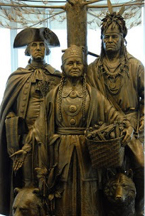
(Statue of Polly Cooper, George Washington, and Chief Skenandoah at the Smithsonian’s Museum of the American Indian)
Sources:
Polly Cooper
http://www.womenhistoryblog.com/2012/04/polly-cooper.html
The Oneida:
http://www.oneidaindiannation.com/allies-in-war-partners-in-peace/
http://www.oneidaindiannation.com/revolutionarywar/
http://www.mountvernon.org/digital-encyclopedia/article/oneida/
https://oneida-nsn.gov/our-ways/our-story/historic-timeline/american-revolution/
http://commons.lib.jmu.edu/cgi/viewcontent.cgi?article=1017&context=madrush
The Six Nations of the Iroquois and the American Revolution
https://www.britannica.com/topic/Iroquois-Confederacy
http://www.americanrevolution.org/ind1.php
http://www.ushistory.org/us/13f.asp
http://www.umbc.edu/che/tahlessons/pdf/The_League_of_Peace_and_Power_PF.pdf
Benedict Arnold
Benedict Arnold is simultaneously one of the most interesting and polarizing figures in American history—both an inspiring, death-defying hero who galvanized so many Patriots to action, and a traitor who betrayed the Revolution.
Arnold’s youth primed him to be a contentious maverick. After his father drank away the family’s money, Arnold had to leave school and apprentice as an apothecary. He fought in the French and Indian War as a teenager, and then became a pharmacist and bookseller in Connecticut. In 1764, Arnold partnered with Adam Babcock in a mercantile business. They purchased three ships to conduct trade in the West Indies (rumor was Arnold may have even smuggled goods at times). When the British imposed the Sugar and Stamp acts, Arnold joined the Sons of Liberty, a subversive secret society best known for orchestrating the Boston Tea Party. Immediately after Lexington and Concord, Arnold and Vermont frontiersman Ethan Allen joined forces to capture Fort Ticonderoga and its canons from the British—supplying the fledgling Continental Army with high-quality artillery guns.
Quickly, Arnold became known as a hard-charging tactician and leader, and rose up the ranks of the Continental Army, an inspiration to his fellow soldiers. He legendarily fought on when his horse was shot out from under him. Pinned under the animal, and faced with Loyalists about to arrest him, Arnold managed to pull out his pistol, shoot his assailants, roll out from under the horse and run to safety. (Arnold’s athleticism was well known even before the war when he had been particularly applauded as a skater.)
Despite his heroism in conflicts such as the siege of Quebec, the Battle of Valcour Island (vitally delaying the would-be-lethal British invasion from Canada), Danbury, and then the pivotal Battle of Saratoga (where he rallied a charge that led to 600 British soldiers being wounded or killed), Arnold became increasingly disgruntled with his perceived lack of recognition from the Continental Congress. Less battle-hardened and deserving men were promoted over him because of regional politics and officer quotas. His prickly nature alienated him from other officers. Some even made legal charges against him.
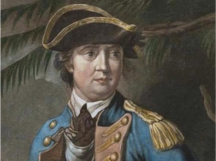
However, Andre was apprehended after meeting Arnold and their plan was discovered. Arnold fled West Point and escaped to the British side, eventually leading Redcoat forces in Virginia battles against his former comrades and soldiers—searing his name into the minds of Americans as a term for traitor.
Sources:
http://www.mountvernon.org/digital-encyclopedia/article/benedict-arnold/
http://www.mountvernon.org/digital-encyclopedia/article/battle-of-saratoga/
http://historyofmassachusetts.org/the-sons-of-liberty-who-were-they-and-what-did-they-do/
http://www.history.com/topics/american-revolution/battle-of-saratoga
http://www.mountvernon.org/digital-encyclopedia/article/west-point/
https://armyhistory.org/buying-time-the-battle-of-valcour-island/
https://www.biography.com/people/benedict-arnold-9189320
http://www.history.com/topics/american-revolution/benedict-arnold
Ann Eliza Schuyler Bleecker
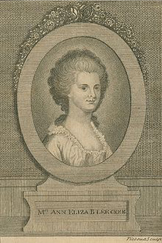
https://www.albany.edu/arce/
https://en.wikisource.org/
Rochambeau
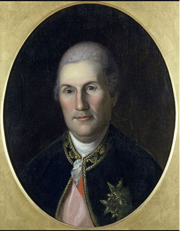
Rochambeau and his troops landed in Newport, Rhode Island in July 1780, bringing desperately needed soldiers, arms, cannons, and energy to the cause. After conferring several times during the long, brutal winter of 1780, Washington and Rochambeau decided to focus their attacks on Yorktown instead of the impenetrable New York City. The victory at Yorktown was in large part thanks to the skill and cunning of Rochambeau's army. Back in France after the war, Rochambeau barely escaped the guillotine during the French Revolution, and permanently retired from the public eye.
Sources:
http://www.mountvernon.org/digital-encyclopedia/article/rochambeau/
https://allthingsliberty.com/page/2/?s=Rochambeau
General Johnny Burgoyne
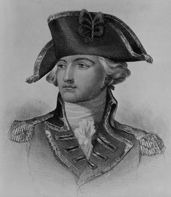
Burgoyne’s plan to seize control of the Hudson River, thereby severing the states, cutting off New England from New York and other Mid-Atlantic forces, was a brilliant one. He marched south from Lake Champlain to reach the northern reaches of the Hudson, then down along New York’s eastern border, while another force under Barry St. Leger attacked western New York from Lake Ontario. The third prong of the invasion would travel north up the Hudson River from New York City, which was occupied by British troops. The three British armies would converge at Albany to crush it.
However, Burgoyne was slowed by his own hubris in carrying 30 carts of personal possessions and champagne, the dense wilderness of upstate New York, and General Philip Schuyler destroying footbridges and damns to make bogs impassable, and felling trees along paths—creating impenetrable thickets of barriers. That allowed him time to rally the militia in force, for the first time giving the Patriots superior numbers when facing the British in battle. The victory at Saratoga—the Patriots first major win—convinced the French that the American Revolution had a chance and was worth supporting. It was the war’s main turning point.
After surrendering, Burgoyne returned to England and his work as a playwright.
Sources: https://www.britannica.
General Horatio Gates
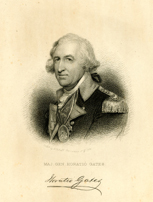
Gates quickly rose to brigadier general and led the Continental Army to various victories—most notably the Battle of Saratoga. But although he was in command of the American forces that won Saratoga, Gates had been granted that position at the very last minute—only after General Philip Schuyler had prepared the army and militia for the fight. Gates, with the Massachusetts delegation, had successfully slandered Schuyler to Congress, which stripped him of command on the eve of the battle.
Gates then set about to undermine George Washington’s reputation, delegitimizing Washington’s authority by reporting the Saratoga victory not to the commander-in-chief, but directly to Congress. Gates also colluded with the Conway Cabal, a plot by Brigadier General Thomas Conway to replace Washington with Gates. Gates’ true colors soon showed. In the critical Battle of Camden in South Carolina, after suffering a heavy loss to British forces, Gates abandoned his army, riding hard, taking just three days to travel two hundred miles. Accused of cowardice, Gates was released from the Continental Army, his reputation never the same.
Sources:
http://www.mountvernon.org/digital-encyclopedia/article/horatio-gates/
http://www.mountvernon.org/digital-encyclopedia/article/conway-cabal/
General Henry Knox
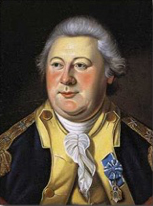
When Knox was nine years old, his father abandoned his family, forcing Knox to quit school and work at a bookbindery to support his mother. But Knox had access to countless books at his job, and educated himself thoroughly on many subjects, including military tactics. Eventually, Knox opened his own London Book Store in Boston. The famed John Adams was one of his customers, who recommended Knox for a position in the Continental Army. Knox quickly made a name for himself in the 1775 mission to steal artillery from Fort Ticonderoga, then controlled by the British army. Washington was so impressed that he made Knox Chief of the Continental Army Artillery, which the former bookseller built into a formidable force.
After the war, Washington appointed Knox the first U.S. Secretary of War. "There is no man in the United States,” said the new president, “with whom I have been in habits of greater intimacy; no one whom I have loved more sincerely, nor any for whom I have had a greater friendship."
Sources:
http://www.mountvernon.org/digital-encyclopedia/article/henry-knox/
https://schuylermansion.blogspot.com/2016/12/by-ian-mumpton-cambr-nov.html
General Nathanael Greene
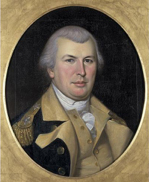
Greene quickly made a name for himself by being one of the few "successful" generals during the Continental Army's streak of losses in 1776, commanding well during the battles of Trenton, Princeton, and Monmouth. Greene really earned Washington's trust, though, when Greene stood by George during the Conway Cabal, where a few rogue officers attempted to replace Washington as leader of the Continental Army with Horatio Gates. Greene served in the grueling all-important role of Quartermaster General from 1778 to 1780, searching for supplies for the army. Then he took control of The Southern Army, which had already had three disastrous commands, including Gates.
Cornwallis’ Redcoats were ravaging the Carolinas and Georgia. Greene adopted Washington’s tactics of quick-hit attacks on the slower-moving British Army. He even led a strategic retreat that lured the British away from their supply depots in Charleston, severely weakening Cornwallis’ forces right before the Battle of Yorktown.
After the war, Greene surely would have had a long and fruitful partnership with President Washington, but sadly he died in 1786. At age 44, Greene suffered a heat stroke while working his fields on a plantation the state of Georgia had deeded him in thanks for his liberating the southern colonies from a harsh and vindictive British occupation.
Sources: http://www.mountvernon.org/digital-encyclopedia/article/nathanael-greene
Joseph Plumb Martin
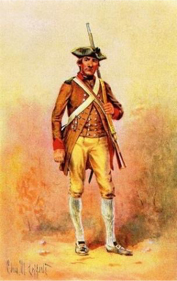
Serving in the Continental Army from 1777 to 1783, Martin fought in most of the war's most pivotal battles, from Valley Forge to Fort Mifflin to Yorktown. His anecdotes and wonderfully colloquial and forthright tone provide fascinating insights into the "common” soldiers, their camaraderie and stubborn grit, and the day-to-day and often life-or-death demands of the Revolution on them. I highly recommend it.
Source: http://www.history.com/topics/american-revolution/joseph-plumb-martin
